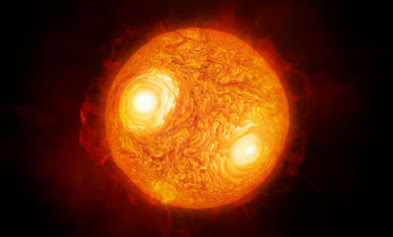Red Giants and Supergiants
The following citations listed in this article are from Red Giant vs Red Supergiant (How Are They Different?) | Scope the Galaxy and How long does the red giant phase of a star last? | Socratic.
According to previously cited sources, "Red giants and supergiants are both process[es] that a star follows once it is unable to convert hydrogen to helium through nuclear fusion," meaning that this phase commences after a star's main sequence is finished. During one's red (super)giant stage, the equilibrium of outward nuclear fusion and inward pressure is thrown off, and they lose the balance they share with each other. Because of this, the star begins to grow tremendously.
You're probably wondering, "What's the difference between a giant and a supergiant?" One obvious answer is that their sizes differ dramatically. Red giants are big, but red supergiants are, well, super big! Their lifespans also differ from each other, as red supergiants move onto the next phase of their lives after around 10 to 50 million years, while red giants move on after what can be almost 2 billion years. Red supergiants are also much more luminous. Since they often have higher mass than regular giants, they obviously will go through different phases than low-mass stars.
Red supergiants have a vast amount of differences when compared to red giants. As noted before, supergiants are a heck of a lot bigger than normal giants. In fact, the largest supergiant known to man is said to be around 1,700 times larger than our Sun! Red supergiants are also extremely bright, with a luminosity anywhere from -5 to -8. (For comparison, our sun has a luminosity of +1.) Everything about them is extreme, especially their temperatures. Most supergiants have temperatures greater than 19,000 degrees Celsius, which is 34,232 degrees Fahrenheit! After being red supergiants, high-mass stars will become supernovas, inevitably dying. Take a look at the image below. Red supergiants are light in color, appearing more orangish-yellow than a red. You can see the heat emanating off of the star, and the texture of the star is more visible than a red giant's. Everything about it is more, well, super.
Image Credits: Closer look at red supergiant Antares suggests convection not enough to remove surface material
Specifically, red giants usually have a luminosity around -2. This means that they are almost 14,000 times brighter than our Sun! Red giants tend to have slow deaths, where they "shed" away their layers until their core is exposed. This happens during a low-mass star's "planetary nebula" stage, and then after that, dwarves will be introduced, but we'll take more about that later. Red giants are very hot, ranging from 2,200 degrees Celsius to 3,200 degrees Celsius. That's 4,892 degrees Fahrenheit! Take a look at the example of a red giant below. As its name implies, the star is very red. In this picture specifically, you can see its light radiating off of its surface. It's fascinating how bright these stars can get!
Red giants and supergiants are similar in some ways, but they can also be very different. While supergiants are more extravagant, don't forget about giants! They are just as fascinating and important.


Comments
Post a Comment